In an age defined by rapid technological progress and fierce competition, a new player in the artificial intelligence (AI) domain has emerged, capturing the attention of industry giants and reshaping the conversation around innovation and efficiency. DeepSeek, a new startup hailing from China, has unleashed its R1 model, reportedly a cost-effective and highly efficient AI tool, causing ripples in the tech world and signaling a potential shift in the balance of global power in AI development.
Reactions from Industry Leaders
The ascent of DeepSeek has been met with a blend of admiration, caution, and concern from other tech stalwarts. Microsoft’s Satya Nadella pointed out what he characterized as “real innovations” in DeepSeek’s model, while OpenAI’s Sam Altman acknowledged its effectiveness by labeling it a “great model.” This blend of recognition and concern illustrates the stakes at play; the tech industry is acutely aware that advancements in AI could tip the scales of competitive advantage not only between corporations but also between nations.
Furthermore, discussions around efficiency have become pivotal, as evidenced by Apple CEO Tim Cook’s comments regarding innovation that drives efficiency. The need for businesses to enhance operational capabilities is underscored at a time when all eyes are on how tech could stimulate economic growth and drive future advancements in artificial intelligence.
DeepSeek’s R1 has reportedly been created for a startling $6 million—a fraction of what competitors in the U.S., such as OpenAI, have spent on their AI models. This comparative financial efficiency has not only raised eyebrows but also led to significant market reactions. Following the announcement, shares in notable chip manufacturers like Nvidia and Broadcom plummeted, resulting in an $800 billion loss in market capitalization. The financial implications indicate a growing recognition that cost-effective AI solutions could redefine the competitive landscape.
Yet differing opinions about DeepSeek’s actual development costs have added layers of complexity. Research firm SemiAnalysis has suggested that DeepSeek’s cumulative costs likely exceed this $500 million mark, fostering skepticism and fueling debates about the viability of such low-cost innovation. These narratives raise questions about the authenticity of claims surrounding the technology and its sustainable success.
The backdrop to DeepSeek’s emergence is a geopolitical rivalry, with the U.S. striving to maintain its position as a leader in AI against China’s rapid progress. President Donald Trump, upon entering his second term, indicated a renewed focus on AI, establishing projects like Stargate aimed at bolstering the U.S. tech infrastructure. Such efforts underscore a pronounced urgency within American politics and corporate strategy to foster domestic capabilities to counterbalance China’s advancements.
Moreover, the leadership in American tech companies remains vigilant. During Apple’s earnings call, Cook was queried about the implications of DeepSeek on computing costs. His response offered a strategic outlook emphasizing innovation driven by efficiency. This recognition of rising competition in the tech sector encapsulates an industry-wide sentiment—that every move by competitors necessitates careful vigilance and strategic recalibration.
The conversation doesn’t merely rest on competition; it also ventures into the realm of commoditization. Nadella highlighted this dynamic by articulating that AI’s trajectory resembles historical trends seen in computing cycles—where breakthroughs eventually lead to broader accessibility and standardization. This perspective challenges the notion that a single impressive model, like DeepSeek’s R1, fundamentally alters the game. Instead, it argues for a broader understanding of market evolution driven by a series of innovations.
Reid Hoffman, an investor and tech entrepreneur, further moderated the concerns voiced by industry leaders. His declaration that the landscape is more nuanced than a binary win or loss scenario paves the way for a strategic introspection, suggesting that, while competition is intensifying, it does not inherently signify impending doom for U.S. technology companies.
As DeepSeek advances into the spotlight of global technology discourse, its implications stretch far beyond immediate financial reactions. The startup’s rise epitomizes the ongoing race for AI supremacy that not only defines corporate strategies but also carries significant national security implications.
Leaders across the globe have been forced to reconsider their positions, driving a relentless quest for innovation amidst growing competition. Altman’s statement that DeepSeek serves as a “wake-up call” resonates with industry executives, calling for a collective understanding of AI’s transformative potential. This unfolding narrative underscores that as the field of artificial intelligence evolves, defense mechanisms, strategic adaptations, and collaborative efforts will govern the future trajectory of global technology leadership.

